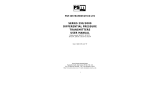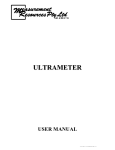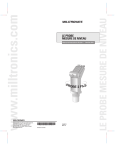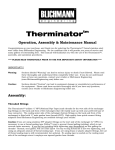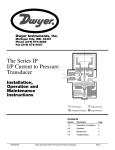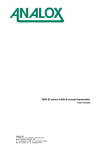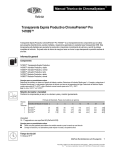Download Ultrameter 5, 7 & 10 user Manual
Transcript
PSM INSTRUMENTATION LTD Ultrameter 5, 7 & 10 user Manual Issue C date: 18/06/2001 Burrell Road Industrial Estate Haywards Heath, West Sussex RH16 1TW, UK Tel: +44 (0)1444 410040 Fax: +44 (0)1444 410121 Http://www.psm-sensors.co.uk E-mail: [email protected] Doc Ref: Man 03 1 The Ultrameter is designed for measuring liquid levels in open and closed tanks. There are intrinsically safe versions available in all ranges. These are approved for use in hazardous areas to EEXia IIC T6. The nose section is manufactured from TEFLONtm a Duponttm material resistant to most chemicals, and includes an integral temperature sensing element to ensure temperature compensation and correct level measurement at all temperatures. The electronics housing is manufactured from UPVC. The entire assembly is sealed and protected against accidental immersion. The transducer transmits a series of short, controlled, ultrasonic pulses towards a surface. The reflected echoes are intelligently conditioned remove any noise, and the time taken for the echoes to reach the sensor face are calculated and converted to distance for transmission as a mA current loop output. The transmitter uses on-board LED’s to confirm power is on and that the transmitter is operating correctly. To calibrate, the zero and span levels of the tank are entered into the transmitter by simply touching the ’Z’ & ’S’ targets, on the transmitter body, with the magnetic key provided. Tank Mounting Flange Mount When flange mounting, use a gasket to ensure acoustic de-coupling hand tighten only. DN50 PN10, 2” ANSI, JIS10K2B Suspended Threaded Pipe 1/2” conduit From it’s Ensure acoustic pipe/hanging own cable de-coupling by hand Preferred for dam, tightening only filter beds and open channel application 2 Transmitter Positioning on Tank Roofs 1/6 D Avoid mounting the transmitter in the centre of the roof of the tank. The recommended position for the transmitter is 1/6 of the diameter from the tank wall. Dimensional Details D 90 mm 2” BSP Thread 55 mm 45 mm Supply Nominal 24 V Intrinsically Safe EEx models only The transmitter is certified intrinsically safe with barriers only. Recommended barriers: MTL 787S+, Elcon 1620-2D-P -R Inspection Authority: SABS S/R164X Certification: EEx is IIC T6 No. 5478/945979/R164 U–i 28 V dc C-i 100 nano F I-i 93 mA I-0 4 to 20 mA P-i O.65 mW L-0 0 L-i 4 micro H C-0 0 3 Hazardous Area I.S. Barrier Nominal 24 V Safe Area Max Loop load = 150Ω 150Ω Minimum voltage required to power up the transducer is 13.6Vdc. Maximum allowable voltage supply to the barrier is 28Vdc The capacitance and inductance or inductance to resistance (L/R) ratio of the interconnecting cable between the transmitter and barrier will not be affected by the transmitter which has zero capacitance and zero inductance storage capacity making the transmitter a very intrinsically safe instrument. Wiring Wiring must conform to standard instrumentation practices and wiring codes. The transmitter is reverse polarity protected. It is also protected against indirect lightning strikes. The cable screen should be connected to earth at the power supply. It must not be connected to the + or - conductors. Calibration The Ultrameter is designed for measuring liquid or solid contents of a tank with the sensor mounted on the top of the tank. It can be calibrated for ‘Level’ or ‘Ullage’. Ultrameter’s are normally delivered calibrated to their nominal ranges as follows:Model Max Sensing Distance Min Sensing Distance Ultrameter 5 4mA set to 5 metres 20mA set to 0.2 metres Ultrameter 7 4mA set to 7 metres 20mA set to 0.25 metres Ultrameter 10 4mA set to 10 metres 20mA set to 0.4 metres 4 Calibration can be carried out ‘in situ’ at actual tank empty and full levels or by aiming the Ultrameter at a target at distances representing empty and full tank levels. During this procedure the Ultrameter must be firmly clamped for optimum results. Calibration Procedure 1. Apply power to the Ultrameter. This is nominally 24vdc but must be >13.6Vdc. Insufficient supply voltage will cause both LED’s to illuminate at 50% intensity. 2. Initially both LED’s will illuminate for about 5secs and then flash while the unit validates the signal. After a further 5-10 seconds LED 1 will go off and LED 2 will begin to pulse, Green if the echo distance is within the Ultrameter’s set range, Red if outside the set range. If LED 2 shows a constant red indication the signal could not be validated and calibration cannot be carried out. 3. To calibrate the output to 4mA hold the magnetic key against the Z target until both LED’s illuminate, remove the key, both LED’s will flash for about 5 to 45 seconds while the Ultrameter validates the signal. LED 1 will then turn off and LED 2 pulse Green indicating calibration is complete and the unit is operating in normal measuring mode. 4. To calibrate the output to 20mA hold the magnetic key against the S target and repeat the procedure for Z setting. NotesCalibration of 4mA and 20mA are independent of each other meaning 3 and 4 above can be carried out in either order. Whereas calibration for liquid level is carried out by setting 4mA at tank empty and 20 mA at tank full, for ullage it is the reverse, calibrating 4mA at full and 20mA at empty. The Ultrameter will operate correctly either way. Calibration from factory The transmitter is calibrated to it’s maximum range and configured 5m per min response rate and 22mA default output current. The transmitter can be configured to suit exact application requirements. If you wish to change the configuration please contact your local agent or supplier for assistance. Configuration possibilities: Response rate 5m/min (averaging) default or immediate Default current 3.8mA 4.0mA 22mA- default 5 The Various LED Combinations L1 L2 Power up Mode & enter Calibrate Mode Green solid On initial power up both LED’s illuminate for approximately 5 Green to 45 seconds whilst unit validates its signal. Both will also illusolid minate when the magnetic key is held to either ‘Z’ or ‘S’ targets to confirm unit has entered Calibrate Mode. Normal Operation Off Following power up mode this indicates a valid echo is being Green received and unit is functioning normally. Where, in normal pulsing operation, there is a sudden step change in the echo distance the unit will automatically go to Validate Mode. When it establishes that the new echo is valid the signal output will change accordingly and the LED’s will return to Normal Operation status. Invalid Range Off This indicates that a valid echo is being received but that the Red distance it represents is outside of the calibration limits which pulsing have been set for the unit. If this distance is known to be valid the unit can be recalibrated to accept this new distance. Calibrate Mode / Validate Mode When calibrate mode is entered and the magnetic key is reGreen Green moved from the ‘Z’ or ‘S’ target both LED’s will flash for apflashing flashing proximately 5 to 45 seconds while the unit verifies the echo. Assuming echo is verified the LED’s go to Normal Operation status. Note that when the magnetic key is held against the ‘Z’ or ‘S’ targets to set calibration the signal will immediately go to 4.00mA or 20mA as appropriate. Low Power Both LED’s are illuminated at 50% intensity indicating insufficient power to drive the circuit. The unit does not pulse. No Echo / Echo Loss Off When, after Power Up mode no echo can be found for approxiRed mately 1 minute LED 2 will illuminate red indicating calibraSolid tion cannot be undertaken. Also, where echo is lost in normal operation, the output signal initially freezes its value. If, after approximately 1 minute of searching a valid echo is not found the output signal goes to the fault condition level set for it and ‘L2’ goes to red. 6 Specifications Range 0.25 to 7m, 0.15 to 5m, 0.4 to 10 m mA Output 4 to 20mA / 20 to 4 mA Accuracy Better than 0.25% of max span Resolution 3 mm Display Two visible surface mount LED’s Power 24 V dc nominal Power Maximum 0.44 watts Power Surge 22 mA on start up Loop current 4 to 20 mA Fault current Set to 22 mA Loop Load Rmax = 250 Ohms Beam angel 8o at –3 dB boundary Response rate 5 metres per minute Temp Comp Built in PT100 for automatic compensation across whole range Temp range -20 to +75 deg C Sensor temp Max 100 deg C (220 deg F) for 30 minutes Pressure (vessel) 200 Kpa (G) (2 bar or 30 PSI) Enclosure rating IP 68 submersible Memory Non-volatile EEPROM Weight 1 Kg including integral 5 metres of cable Mounting 2” BSP Intrinsic safety EEXia IIC T6 (EEx versions only) Construction Combined sensor and housing label cover clear acrylic Electronic housing UPVC Sensor face TEFZELTM 7 Burrell Road Industrial Estate Haywards Heath, West Sussex RH16 1TW, UK Tel: +44 (0)1444 410040 Fax: +44 (0)1444 410121 Http://www.psm-sensors.co.uk 8E-mail: [email protected]








